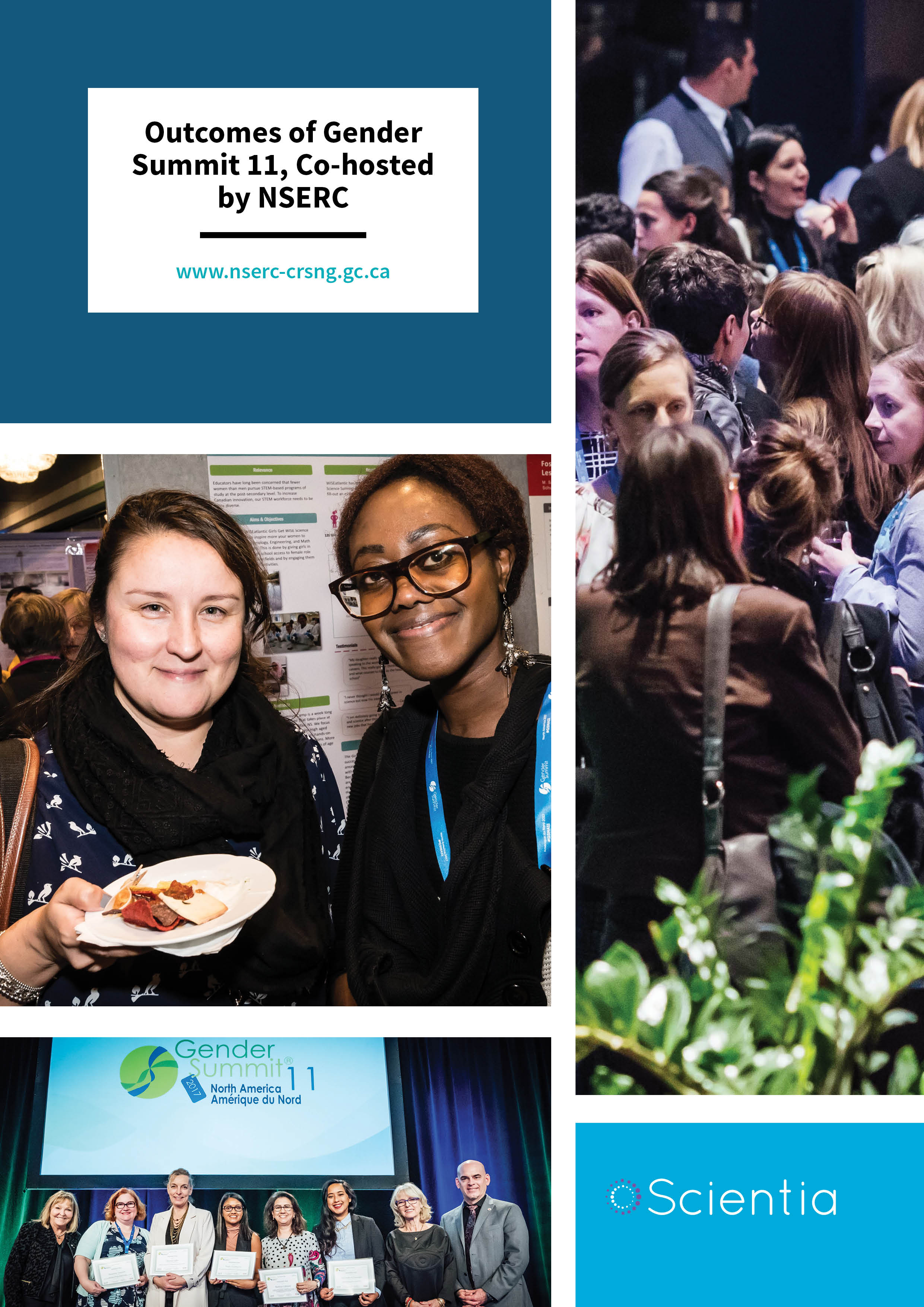Outcomes of Gender Summit 11, Co-hosted by NSERC
From November 6 to 8, 2017, more than 675 advocates of gender equity from across many different fields in science, technology, engineering and mathematics (STEM) took part in Gender Summit 11, in Montreal, Quebec.
Co-hosted by the Natural Sciences and Engineering Research Council of Canada (NSERC) and Fonds de recherche du Québec, the Gender Summit’s aims were to highlight the importance of diversity and to share best practices for how to eliminate barriers faced by under-represented groups, such as women, in the STEM community. Under the overarching theme of ‘Embracing pluralism and thriving through diversity – shaping science and innovation’, the Summit’s participants had the opportunity to engage in many important discussions, from how to reduce conscious and unconscious bias on hiring committees, to how to boost the number of women in leadership roles.
In this exclusive interview, we had the pleasure of speaking with Dr Catherine Mavriplis, Dr Tamara Franz-Odendaal and Dr Annemieke Farenhorst, chairholders of the Chairs for Women in Science and Engineering Program, along with NSERC’s president, Dr B. Mario Pinto. Here, they share some of the key outcomes of the Summit, highlight the latest success stories and discuss the challenges ahead for achieving full equity in the STEM community.
To start, could you briefly explain the overall aim and vision behind Gender Summit 11?
Dr B. Mario Pinto: Yes, I can. But, first, let me preface my comments by saying that the Gender Summit has been going on for a while. We joined the program at Gender Summit 3, and we’ve been participating in the other Summits. But by attending those Summits, I realised that we have to broaden the discussion beyond the differences in biological sex – between male and female. We really have to look at the other conflating factors of culture, ethnicity and other sources of diversity.
And so, when we put in our bid to run the North American conference, we decided that we would expand the theme of the Gender Summit to include pluralism and inclusion in all its aspects. With that in mind, the overall vision was to embrace diversity and to have a discussion of the other factors that would affect the gender balance in hiring, business, academia and so on.
‘The research has shown that diversity of opinion leads to much better decision-making, unusual decision-making and non-linear thinking – if I can put it that way – where you have different viewpoints and perspectives brought to bear on solving a particular problem.’
It really is a very complicated, multivariable equation, if one considers different cultures at play, different races, different ethnicities, etc. That’s why we put together this fairly broadly-based programme. I would be remiss if I didn’t mention the indigenous aspect. So, we arranged specifically to hear from indigenous peoples and to consider their points of view as we debate the broader issues of gender equity and inclusion.
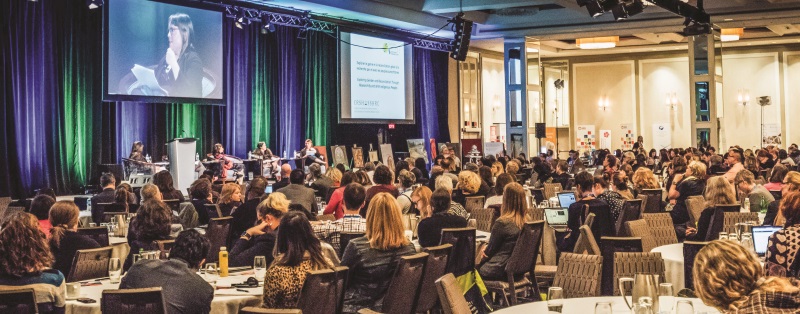
Women are still under-represented in science and engineering. Explain how equality and diversity add to the scientific and engineering community and increase the relevance and quality of the research.
Dr B. Mario Pinto: The research has shown that diversity of opinion leads to much better decision-making, unusual decision-making and non-linear thinking – if I can put it that way – where you have different viewpoints and perspectives brought to bear on solving a particular problem. This is true in an academic setting, but it’s also true in a business setting where, a report by McKinsey and Company has definitely shown that incorporation of diverse opinions and peoples in companies leads directly to economic gain, and there’s now been a correlation shown between gross domestic product (GDP) and diversity.
On the academic side, there are many cutting-edge problems that need to be attacked, and here, too, one needs a diversity of perspectives. If one thinks the same way and one has no fresh input, what you get is a propagation of the same way of thinking. So, really, what you want is disruptive thinking. And that disruptive thinking usually comes from very diverse perspectives. We know that different people think very differently because of their backgrounds.
In terms of science and engineering, we have many global challenges. To solve them in a reasonable timeframe, I think we have to join forces and embrace diversity of opinion and thought so that we can proceed toward the end goal. Definitely, we can show that the impact of the research is much higher when you have different points of view brought to bear on a particular problem. So, it comes about by looking at evidence, looking at research, and coming to the logical conclusion.
Dr Catherine Mavriplis: I would say that things have changed a lot over the last few decades. There are certainly some fields of engineering, in particular, that are doing really well because of the inclusion of more women. Maybe those could even rise further because of more balanced participation. An example is biomedical engineering, which in a lot of universities is a newer program, and ours is 50% men and women in terms of students and in terms of faculty as well.
But there are other fields that do well. Both in science and engineering, by increasing diversity and looking at equality, there are new things that are happening. For instance, just in the last couple of years at the University of Ottawa, there’s been a lot around entrepreneurship and women in entrepreneurship, so I’ll give you a couple of examples. We run a peer mentoring program with women entrepreneurs in the Faculty of Engineering. We’ve had a huge increase, starting from zero or one person to now a 50/50 split in terms of all of our competitions for entrepreneurship. But also, the types of things that they’re coming up with as ideas for entrepreneurial ventures are increasingly associated with making a difference in society. We have students coming up with solutions to work with Syrian refugees who have arrived recently in Canada. We have a student who’s looking at feedback devices for women’s health problems and things like that. So, I think you will see change in both science and engineering as you include more women, and, if we can convince the people with the money or the power to invest in these areas, I think this is one major outcome.
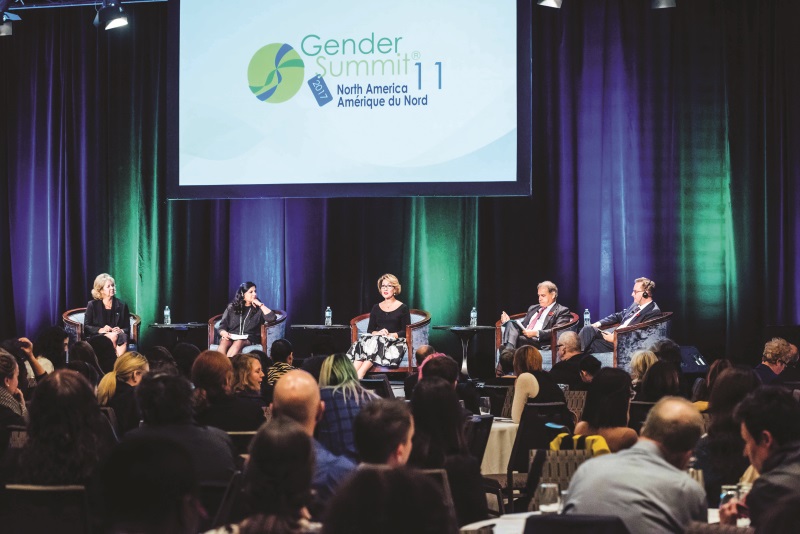
From schools, to universities, to a career in research, at what point do you think women are most under-represented or struggling to progress in science and engineering?
Dr Tamara Franz-Odendaal: I think when we’re talking about under-representation of women in science and engineering, we really can’t lump all the subdisciplines in science and engineering in the same category. So, when we’re looking at, for example, biology, we have no problem recruiting women into biology, but we still have a problem after they reach the PhD level to get into academia or industry. But when you’re looking at engineering or computer science, there’s a problem at the recruitment level into those programs.
If you have a problem at the recruitment level, you’re going to have a problem when you are trying to hire women in these STEM programs because the pool is just that much smaller. So we really do need to use different strategies for the different subdisciplines within STEM. I think the point that is common among them all – where we really see a massive under-representation – is in leadership within STEM. We need to see a shift in the leadership so that we can do better hiring, use better hiring practices and better recruitment strategies and increase our talent pool when we are looking to hire women in STEM.
What specific measures do you think are required to increase gender equality and diversity within academia? How is NSERC working to achieve that?
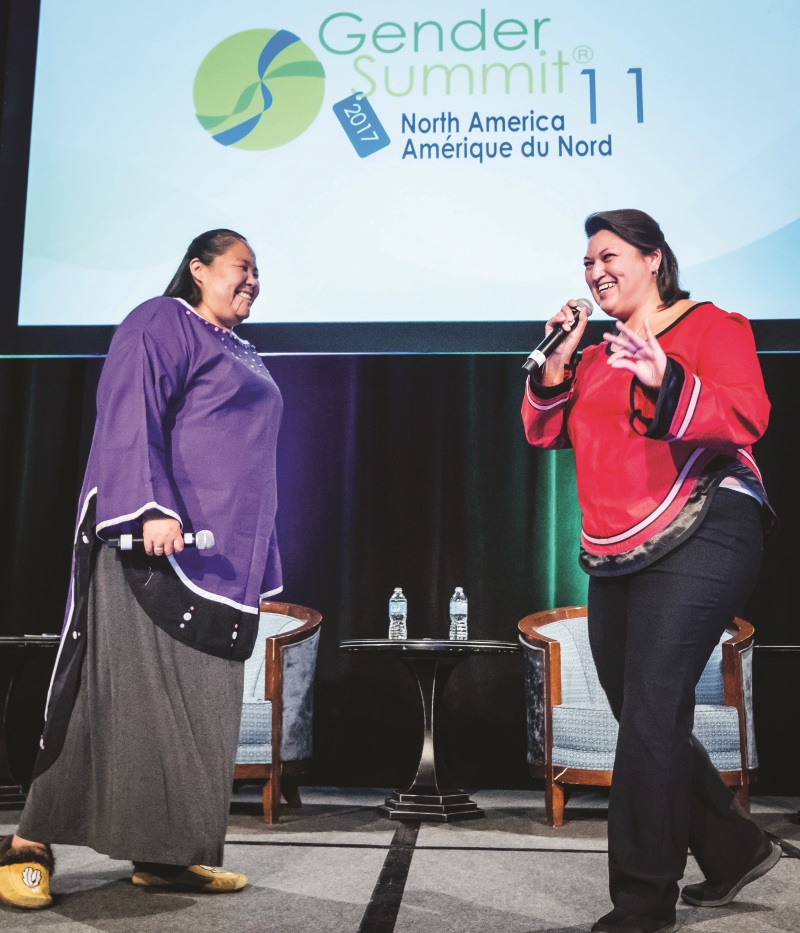 Dr B. Mario Pinto: In order to have this balance, or any change in the ratios of faculty complements of under-represented groups, including women and indigenous peoples, one really has to begin with education of the current faculty complement – education in terms of conscious and unconscious bias.
Dr B. Mario Pinto: In order to have this balance, or any change in the ratios of faculty complements of under-represented groups, including women and indigenous peoples, one really has to begin with education of the current faculty complement – education in terms of conscious and unconscious bias.
This consists, first, of education in the value of diversity as I’ve just articulated, but then, second, of education in the principles and practice of conscious and unconscious bias. And it begins there. Although we train a great number of women in post-doctoral areas, for some reason, they are not hired at the same rate as their male counterparts, even though we attest to their excellence in research. So we feel that there is a bias, and it needs to be addressed at that initial phase of hiring – that’s the first step. The next step, of course, is progression through the ranks, where it’s a little bit more complicated, because there are different cultural pressures, and one has to take those into account.
You asked how NSERC is working to achieve this. We’ve realised, and others have too, that we have to recognise that women, for example, may have non-linear career paths. It’s not all in lockstep like their male counterparts, and there may be gaps. There may be gaps for child-rearing, there may be gaps because they come from other career paths and so on. One really has to recognise that this is just a fact of life, and that one should take those differences into account. Assessment of a curriculum vitae then has to be done differently, because if one uses traditional measures, one will not arrive at the same conclusion about the quality of that candidate because, for example, there may be gaps in publications because of child-rearing and so on.
What has NSERC done? Several things. First, we’re making allowances for maternity leave. We extend grants automatically, but we start even further back with graduate students and postdoctoral fellows. We reassure them that they have paid parental leave if they are raising children or having children. It starts at that level. After they are hired as faculty, then we make sure that we extend their grants automatically and that they’re given a chance to get back in the workforce full-time and keep producing at a scholarly level.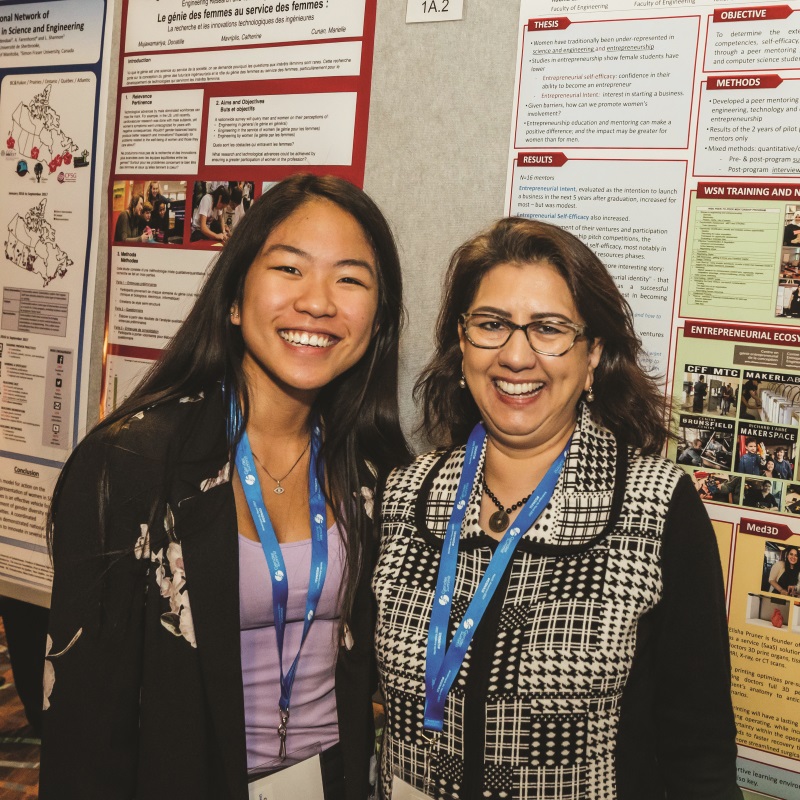
That’s one of the things we’re doing. The other is, we’re educating our grant evaluators – we have many peer reviewers – in conscious and unconscious bias. And I think it begins there. Of course, these are all faculty members, and we’re hoping that there will be multiplier effects as they go back to their universities and adopt our practices in those institutions because, as I said, it starts there. We have to get past this issue of conscious and unconscious bias and, in particular, how we evaluate individuals differently. They all have different circumstances, yet we have in the past been pretty uniform in how we assess candidates: numbers of publications and international presentations. That may not be the best way, as parents may not find it convenient to travel in the same way as people without children.
We are living in a very different world, where access to information is now freely available on the web. One has Skype and other modes of communication. Perhaps we should be re-examining the traditional measures of success. And I think that’s really what it comes down to. We have to ask about impact and how we’re measuring impact. Are the measures of impact correct? And I think we’ve come a long way. We have generated an equity framework at NSERC, and we have come up with a strategy to assure ourselves that we’re giving all candidates the best possible chance when they are evaluated.
‘It’s about providing opportunities for people to see themselves as leaders. If you want to have more diversity in leadership, you should give people from a diverse background or from all segments of the society opportunities.’
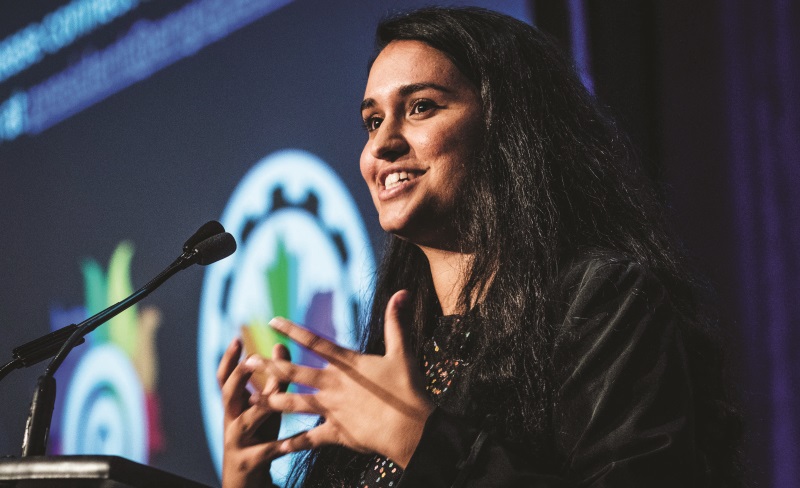
How can more diversity in leadership roles be promoted and future strong role models be supported?
Dr Tamara Franz-Odendaal: I think one of the clear messages we heard today at the Gender Summit was: if we use the same strategies, we’re going to get the same results. We really need to change the way we’ve been doing things, and our Chief Science Advisor for Canada gave a great example today in her keynote speech, which was the example of how we view excellence in research.
Traditionally (in the past) and actually (right now), we use the number of international talks that a researcher has done as an indicator of research excellence, and that is not a family-friendly policy or criterion. So that’s one example of how using the same strategies is going to end up with the same result.
Dr Annemieke Farenhorst: It’s about providing opportunities for people to see themselves as leaders. If you want to have more diversity in leadership, you should give people from a diverse background or from all segments of society opportunities. And one of the things I can think about are leadership workshops for women, which, I think, are very, very important, so people can actually learn skills or advance their skills and feel more confident in being a leader.
Dr Catherine Mavriplis: Today at the Summit, we heard from Dr Elizabeth Cannon, and now we know more about the academic area in promoting leaders. She mentioned ELATE (Executive Leadership in Academic Technology and Engineering) as a program that trains leaders at Drexel University in engineering. This program comes from ELAM (Excellence Leadership in Academic Medicine at the Duke University School of Medicine), in which women can get some mentoring and training to step into leadership roles.
In our country, we’ve been told now by Minister of Science Kirsty Duncan that the universities won’t get their funding unless we meet diversity targets, so people are starting to mobilise there.
But Dr Cannon said it’s important to make sure there are women who are already positioning themselves well for these leadership positions. It’s up to the faculty, when they take these new leaders on, to make sure they’re part of the team and that they’re moving forward, to be able to do those things in the future.
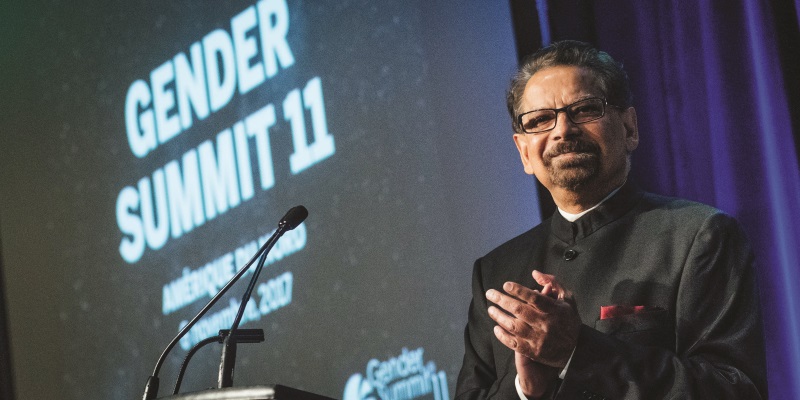
How can the challenges of including other minorities and communities such as indigenous people and those with different gender identities start to be addressed?
Dr Annemieke Farenhorst: I guess there are two very different parts to that question. If I focus on the indigenous people, when I think about Canada, we certainly need more university graduates to meet the labour market demand, and indigenous people are the fastest-growing segment of Canadian society. So, for example, in the province where I live in – Manitoba – one in every five pre-schoolers are indigenous. It’s the same in the neighbouring province of Saskatchewan.
We know that the indigenous population is fast-growing, but when it comes to university degrees, relatively speaking, a smaller proportion of indigenous people have a university degree compared to the non-indigenous Canadian population. So I think it is certainly important to be more inclusive. We are at the Gender Summit in Montreal, and one of the panellists today is Zabeen Hirji, who said something profound: ‘Diversity is a fact, but inclusion is a choice’.
When we are thinking about inclusion, it should really be part of the strategic plan of organisations to actually make the workplace inclusive, whether we’re talking about indigenous people, people of different genders, visible minorities and so forth. It really has to be supported at the top.
When I think about universities, there are a number of universities across Canada that have looked at indigenisation of their institutions – what that may mean and how that can be done. I think what is important within a university setting is the indigenisation of the curricula but also indigenous leadership in universities so students can actually see themselves. They can see the role models, and they can strive for something; they can also feel at home within the institution. So I think it’s very important to look at curricula and expanding that as well as focusing on recruiting role models within universities or other organisations so that the young people can actually see themselves in those role models.
Overall, what do you see as the main challenges getting in the way of increasing diversity and inclusion in science and engineering? How do you hope Gender Summit 11 will contribute to facing these problems?
Dr B. Mario Pinto: Let me start with Gender Summit 11. I think the most useful thing about all of these Summits is the conversations one has. One brings to the fore these critical questions; one asks hard questions; one shares best practices between different groups and different cultures; and, by sharing best practices, one takes those back to one’s institution. Implementation of some of the best practices, for example, in Ireland, will lead us in the right direction to assuring greater gender equity in hiring practices. So that will increase diversity and inclusion in science and engineering.
The challenges, of course, are at the initial level, with those research peer review committees. One has to ensure diversity on those committees to begin with. It’s going to take some time, because we can show clearly that inclusion of diverse groups leads to very different decision-making, and that includes decision-making with respect to hiring, with respect to choosing candidates for awards, etc. In the long-term, these small steps will lead to change, but it’s going to take some time because it will take some turnover in the professoriate to complement these practices and adjust the gender balance.
Of course, the face of Canada is changing dramatically. Immigration is increasing. We’re attracting foreign students, many of whom are staying and joining the workforce. Given that change in demographic, one would expect also a change in inclusion and diversity practices. But it will take time. There will be a lag time. But putting these policies in place and having open discussions in gender summits will get us all moving in the right direction together.

